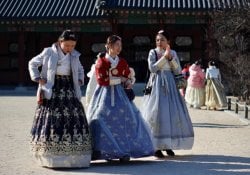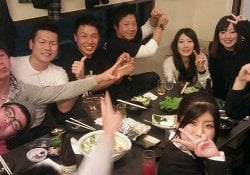Discover the most popular Korean drink in the world Soju!
Soju (Hangul: 소주; hanja: 燒酒) is a popular beverage not only throughout North and South Korea, but around the world and is usually found in small bottles of 360ml or even 200ml.
One of the factors that helped to increase this popularity is the Korean dramas/movies and its celebrities and K-pop (Korean pop) groups/bands.
This article is not intended to encourage alcohol consumption, but to provide information about the Korean drink soju. Drink with moderation!
Let's get to know a little more about this drink that is the favorite of Koreans and of those who also appreciate the Korean culture/wave (Hallyu).
Índice de Conteúdo
What is Soju?
Soju (소주) is a Korean distilled alcoholic beverage that has been popular in South Korea for many years.
The traditional ingredient in its manufacture is rice, but it can be found with others such as sweet potato, wheat, barley and tapioca. Generally its alcohol content varies from 16-17% to 45%.
Distilled drink is a process that separates two distinct liquid substances, usually water from alcohol, from a liquid fermented from grains. With this separation it is possible to add more alcohol by increasing the alcohol content, “main objective“of a distilled beverage.
History
The origin of soju dates back to the 13th century (Goryeo dynasty) with the Yuan Mongols, who learned the distillation technique Arak of the Persians, in their invasion between the years 1231–1259 in Korea.
The Mongols made bases in the capital Gaegyeong, Andong, Cheju Island among other places, with plans to make an expedition to Japan (invasion) where distilleries were built transmitting the distillation process.
During the centuries that passed soju was used both as a drink only for the high society of the time and for medicinal purposes.
Over time the locals learned to produce inside their homes, thus becoming a drink for anyone and not just the elite.
In 1965, with the scarcity of rice, the government banned the use of this ingredient to produce the drink and it was then that production with other grains such as sweet potatoes, tapioca, wheat, barley among others began to emerge.
Even with the lifting of the ban in 1999 allowing manufacturers to return to using rice, many continue to use a variety of grains today.
Today we find the most diverse flavors and brands of this Korean drink.
brands
There are so many brands of soju that it is difficult to know which one to choose, but there is one that has been a world leader for many years.
The company HiteJinro makes very popular brands such as Chamisul which has an alcohol content of 19% and Chamisul Fresh which has 17.8%.
According to the website "Drinks International” since 2001, Chamisul is the number 1 distilled beverage among 180 brands. In 2018, it sold more than 78 million 9-liter boxes worldwide.
We have others popular brands according to each region/province.
| Brand | region/province |
| Chamisul | Seoul, Incheon and Gyeonggi |
| Chum-Churum | Gangwon |
| O2 Linn | Daejeon and Chungcheongnam |
| Cool Cheongpung | Chungcheongbuk |
| hit | North Jeola |
| Charm | Daegu and Gyeongsanbuk |
| Goodday | Ulsan and Gyeongsangnam |
| White | Ulsan and Gyeongsangnam |
| C1 | Busan |
| Yes | Busan |
| Yipsejoo | Gwangju and South Jeolla |
| AHop Si Vahn | Gwangju and South Jeolla |
| hello | Jeju Island |
The following image shows the favorite brands of Koreans in 2018 according to the Statista website:
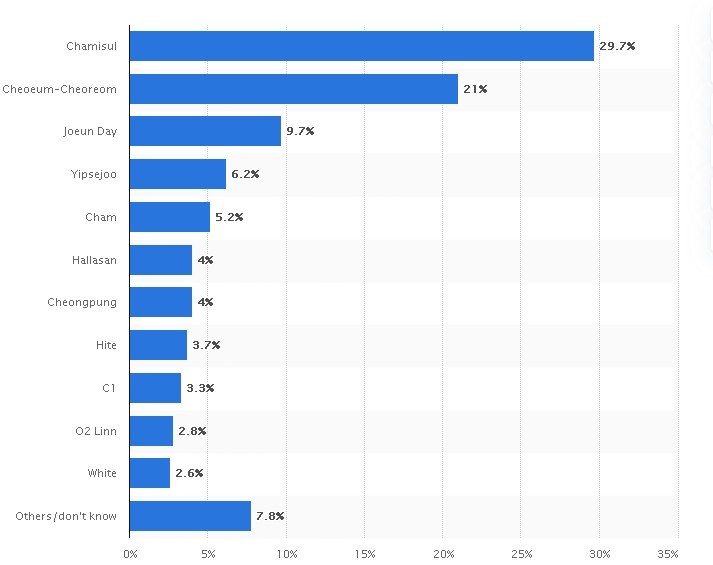
In North Korea it has its own brand also the Pyongyang Soju, since 2009 at the food factory on Taedong River.
The article is still halfway through, but we recommend also reading:
fruit soju
In order to increase sales, the most popular brands began to manufacture flavors of the most varied fruits in their drinks.
Some of the most popular flavors are:
- Blueberry
- Lemon
- Plum
- Peach
- Strawberry
- Green grape
- Grapefruit (Grapefruit)
Brands such as Hintejiro, C1, Chum Churum among others are the best known manufacturers.
premium soju
Following the principle of traditional manufacturing, we have some brands that produce some premium soju that in addition to promising a quality above the popular ones (in manufacturing), the price is also well above.
Andong Soju is made by a renowned family, more specifically by Cho Ok Hwa currently, in the Andong region (possibly uses the traditional method brought by the Mongols) which uses the best techniques/home methods that have been passed down from generation to generation.
The Kwangjuyo company/group that manufactures ceramics also produces one of the sojus high quality premiums.
The Hwayo emphasizes that in its manufacture they use the purest water, 100% Korean rice and with more than 700 years of tradition.
There are numerous sojus considered premium, Hitejinro itself manufactures, for example, the Chamnamootong Margeunisul, Ilpoom JINRO.
Drinks with Soju
Some complain that soju is a “tasteless drink”, they simply don't like the traditional flavor of the best-selling brands or want to give it a new flavor by creating the most varied drinks.
Most of the drinks/bombs are mixed with beer from brands like Cass and Hite.
Below you will see the most popular among Koreans and foreigners:
Somaek (소맥)
It is nothing more than the mix of soju plus Korean beer (Maegju – 맥주) in which the amount of each item varies greatly, but it is usually 30% of soju and 70% of beer.
After mixing the two ingredients, you usually take a spoon, dip it into the glass with the drink and hit the bottom generating a kind of whirlpool.
Poktanju (폭탄주)
It is similar in mix to somaek, but the difference is that the soju glass is thrown into the beer glass. It is often stacked in several cups, knocking them over in sequence.
Kojinkamrae (고진감래)
This is adding one more ingredient and getting it like this; 1 glass of soju + glass of beer + glass of Coke (the size of a soju glass).
For prepare the kojinkamrae It's simple. Inside the empty glass, soju and Coca-Cola are added and then the beer is poured.
There are many other types of drinks, including one that will Soju + Sprite + Yakult, but those above are the most popular. See a video about it below:
Overall the soju cup is 5cm x 5.5cm in size.
Etiquette when drinking Soju
For those who know a little about South Korea, you know that in addition to the language, there is an emphasis on the way of speaking informally and formally (as well as Japan) for the most varied situations.
When drinking with friends, bosses and other people we also have to know how to behave in this type of situation.
When you meet a superior or older person and he offers you a drink:
- Hold with both hands, one palm holding the cup and the other around it while keeping your head slightly lowered.
- When drinking, turn your face to the side, still holding it with both hands, towards your superior/older person. If it's your first glass, turn it all over in one go.
Another way to show respect is to hold the glass with one hand and support the arm with the other hand while the person fills your glass.
If the person is a close friend, you can only hold them with one hand.
follow-ups
Drinking alcohol on an empty stomach is not recommended, as it somehow makes you less resistant to alcohol, making you more susceptible to getting drunk.
That's why we always see some kind of dish and side dish when drinking soju and they are one of the most varied in Korean food.
calls from angel (안주 – Snack) the side dishes that are served together with alcoholic beverages.
Samgyeopsal (삼겹살)
Samgyeopsal literally means pork belly, but in this case it is skinless. Very popular among Koreans.
The meat comes raw for you to roast yourself on the grill and can be accompanied by lettuce, garlic and other foods. It can be considered the Korean barbecue.
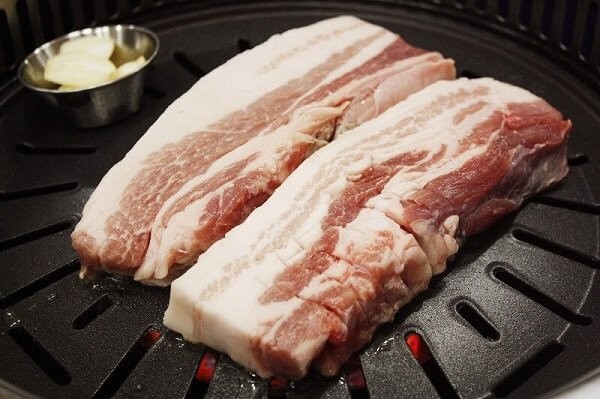
Jokbal (족발)
Jokbal, pig's foot, is also one of the most requested foods by Koreans. It is usually sautéed with soy sauce, ginger, garlic and rice wine.
Dakbal (닭발)
They are well-spiced chicken feet that are fried or grilled and come with or without the bone.
To eat, you need to wear disposable gloves. It often appears in Korean movies and series.
There are many more snacks that are considered good to accompany an alcoholic drink.
Soju in the dramas
You hardly see scenes, in Korean series or movies, in which they drink some kind of alcoholic beverage.
Often they drink until they drop and don't remember what happened last night. It is very common to see this. There are cases where they order Korean fried chicken (순살치킨) to have with a drink.

Soju always appears as it is a very cheap drink, around 1 USD, in South Korea and also has a strong commercial appeal. Many celebrities, whether actors or music groups, make commercials for this drink.
To get an idea actors like IU (Lee Ji-Eun), Suzy (Bae Su-ji), Lee Min-Jung, Hyuna, Song Joong-ki, Irene (Red Velvet) and many others have done or do commercials.
I believe those sojus in boxes (soju box), sold for many years, also contributed to the increase among Koreans in the consumption of this drink.
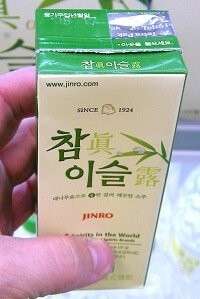
Note that it can easily be confused with a juice that uses similar packaging.
Recently the South Korean government is reviewing the alcohol promotion law in which celebrities appear on labels.
It's normal for a Korean to drink after work as it's like an extension of him. Anyone who refuses is frowned upon by colleagues. It's a kind of fraternization to get closer.
The drinking culture in South Korea is strong, it's not hard to find people fallen on the street from drinking so much. What also helps a lot is that on every corner you can find a store that sells soju.
South Korea is the most alcohol-drinking country in the world.
Research shows that South Koreans drink far more than any other people in the world, averaging a staggering 13.7 shots of drink per person per week. Source.
Not everything is flowers, is it? If you are going to drink in moderation and enjoy the best of this culture that is on the rise these days!
Did you like the article? Don't forget to share with all your friends who like the Korean culture!
Sources: linked in the article and queries to Korean magazine
Originally posted on asian foods.




